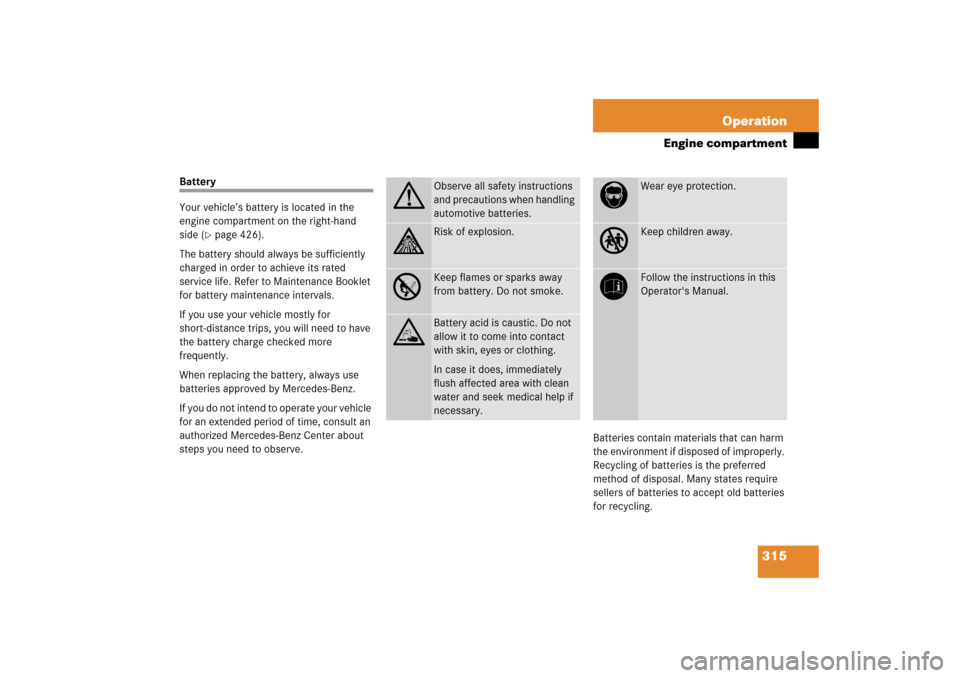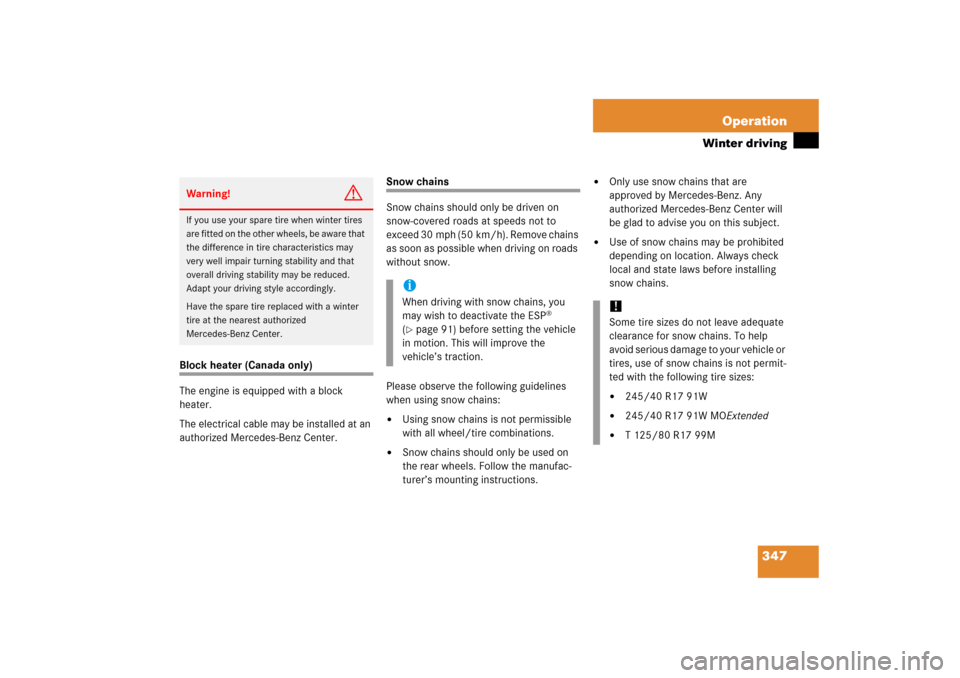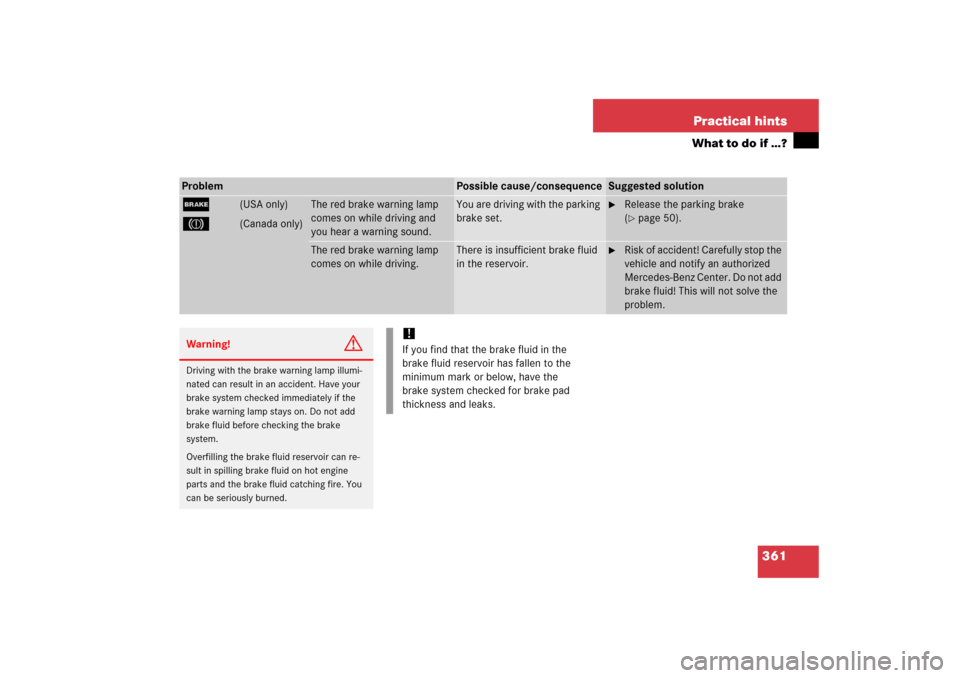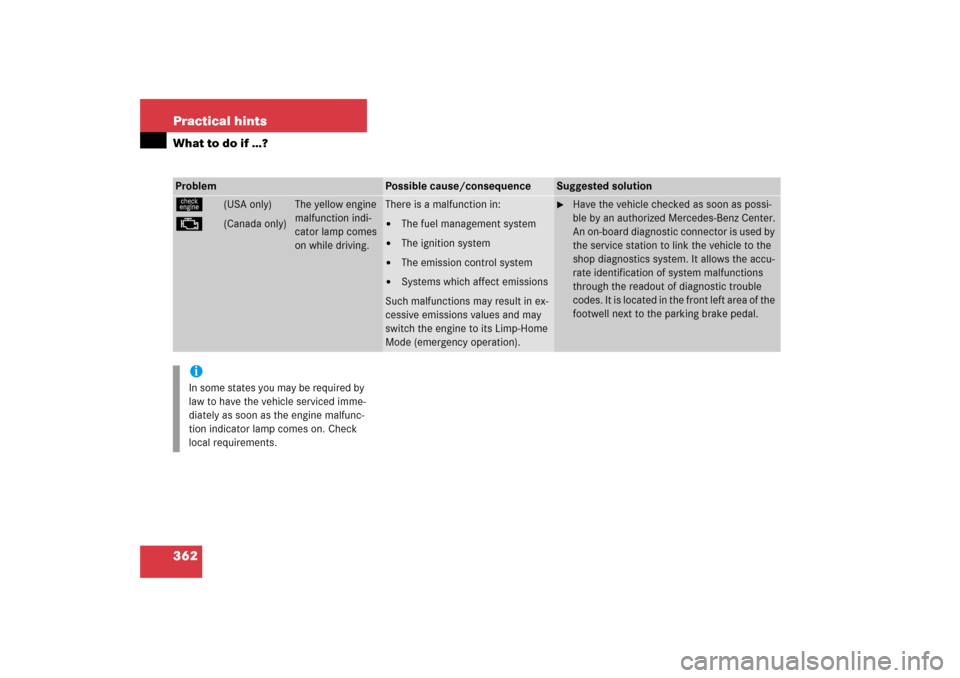Page 314 of 489
313 Operation
Engine compartment
CLK 3501Filler capCLK 5001Filler cap
�
Unscrew filler cap1 from filler neck.
�
Add engine oil as required.
Be careful not to overfill with oil.
Be careful not to spill any oil when adding.
Avoid environmental damage caused by oil
entering the ground or water.
�
Screw filler cap1 back on filler neck.
More information on engine oil can be
found in the “Technical data” section
(
�page 452) and (
�page 454).
Transmission fluid level
The transmission fluid level does not need
to be checked. If you notice transmission
fluid loss or gear shifting malfunctions,
have an authorized Mercedes-Benz Center
check the automatic transmission.
!Excess oil must be siphoned or drained
off. It could cause damage to the
engine and catalytic converter not
covered by the Mercedes-Benz Limited
Warranty.
Page 315 of 489

314 OperationEngine compartmentCoolant
The engine coolant is a mixture of water
and anticorrosion/antifreeze. To check
the coolant level, the vehicle must be
parked on level ground and the engine
must be cool.
The coolant expansion tank is located on
the passenger side of the engine
compartment.
1Coolant expansion tank
2Cap
�
Using a rag, turn cap 2 slowly
approximately one half turn counter-
clockwise to release any excess pres-
sure.
�
Continue turning the cap 2 counter-
clockwise and remove it.
The coolant level is correct if the level
�
for cold coolant: reaches the marking
(plastic bridge) inside the reservoir
�
for warm coolant: is approx. 0.6 in
(1.5 cm) higher
�
Add coolant as required.
�
Replace and tighten cap 2.
More information on coolant can be found
in the “Technical data” section
(
�page 457).
Warning!
G
In order to avoid any possibly serious burns:�
Use extreme caution when opening the
hood if there are any signs of steam or
coolant leaking from the cooling system,
or if the coolant temperature indicator
indicates that the coolant is overheated.
�
Do not remove pressure cap on coolant
reservoir if the coolant temperature is
above 158°F (70°C). Allow the coolant
to cool down before removing cap. The
coolant reservoir contains hot fluid and
is under pressure.
�
Using a rag, slowly open the cap approx-
imately
1/2 turn to relieve excess pres-
sure. If opened immediately, scalding
hot fluid and steam will be blown out un-
der pressure.
�
Do not spill antifreeze on hot engine
parts. Antifreeze contains ethylene gly-
col which may burn if it comes into con-
tact with hot engine parts.
Page 316 of 489

315 Operation
Engine compartment
Battery
Your vehicle’s battery is located in the
engine compartment on the right-hand
side (
�page 426).
The battery should always be sufficiently
charged in order to achieve its rated
service life. Refer to Maintenance Booklet
for battery maintenance intervals.
If you use your vehicle mostly for
short-distance trips, you will need to have
the battery charge checked more
frequently.
When replacing the battery, always use
batteries approved by Mercedes-Benz.
If you do not intend to operate your vehicle
for an extended period of time, consult an
authorized Mercedes-Benz Center about
steps you need to observe.Batteries contain materials that can harm
the environment if disposed of improperly.
Recycling of batteries is the preferred
method of disposal. Many states require
sellers of batteries to accept old batteries
for recycling.
G
Observe all safety instructions
and precautions when handling
automotive batteries.
A
Risk of explosion.
D
Keep flames or sparks away
from battery. Do not smoke.
B
Battery acid is caustic. Do not
allow it to come into contact
with skin, eyes or clothing.
In case it does, immediately
flush affected area with clean
water and seek medical help if
necessary.
E
Wear eye protection.
C
Keep children away.
F
Follow the instructions in this
Operator's Manual.
Page 347 of 489

346 OperationWinter drivingBefore the onset of winter, have your
vehicle winterized at an authorized
Mercedes-Benz Center. This service
includes:�
Check of anticorrosion and antifreeze
concentration.
�
Addition of cleaning concentrate to the
water of the windshield and headlamp
cleaning system. Add MB Concentrate
“MB SummerFit” to a premixed wind-
shield washer solvent/antifreeze
which is formulated for temperatures
below freezing point (
�page 459).
�
Battery test. Battery capacity drops
with decreasing ambient temperature.
A well charged battery helps to make
sure that the engine can be started
even at low ambient temperatures.
�
Tire change.
Winter tires
Always use winter tires at temperatures
below 45°F (7°C) and whenever wintry
road conditions prevail. Not all M+S rated
tires provide special winter performance.
Make sure the tires you use show the
mountain/snowflake.marking on the
tire sidewall. These tires meet specific
snow traction performance requirements
of the Rubber Manufacturers Association
(RMA) and The Rubber Association of Can-
ada (RAC) and have been designed specif-
ically for use in snow conditions. Use of
winter tires is the only way to achieve the
maximum effectiveness of the ABS and the
ESP
® in winter operation.
For safe handling, make sure that all
mounted winter tires are of the same make
and have the same tread design.Always observe the speed rating of the
winter tires installed on your vehicle. If the
maximum speed for which your tires are
rated is below the speed rating of your ve-
hicle, you must place a notice to this effect
where it will be seen by the driver. Such no-
tices are available at your tire dealer or any
authorized Mercedes-Benz Center.
Warning!
G
Winter tires with a tread depth under
1/6in
(4 mm) must be replaced. They are no
longer suitable for winter operation.
Page 348 of 489

347 Operation
Winter driving
Block heater (Canada only)
The engine is equipped with a block
heater.
The electrical cable may be installed at an
authorized Mercedes-Benz Center.
Snow chains
Snow chains should only be driven on
snow-covered roads at speeds not to
exceed 30 mph (50 km/h). Remove chains
as soon as possible when driving on roads
without snow.
Please observe the following guidelines
when using snow chains:�
Using snow chains is not permissible
with all wheel/tire combinations.
�
Snow chains should only be used on
the rear wheels. Follow the manufac-
turer’s mounting instructions.
�
Only use snow chains that are
approved by Mercedes-Benz. Any
authorized Mercedes-Benz Center will
be glad to advise you on this subject.
�
Use of snow chains may be prohibited
depending on location. Always check
local and state laws before installing
snow chains.
Warning!
G
If you use your spare tire when winter tires
are fitted on the other wheels, be aware that
the difference in tire characteristics may
very well impair turning stability and that
overall driving stability may be reduced.
Adapt your driving style accordingly.
Have the spare tire replaced with a winter
tire at the nearest authorized
Mercedes-Benz Center.
iWhen driving with snow chains, you
may wish to deactivate the ESP
®
(
�page 91) before setting the vehicle
in motion. This will improve the
vehicle’s traction.
!Some tire sizes do not leave adequate
clearance for snow chains. To help
avoid serious damage to your vehicle or
tires, use of snow chains is not permit-
ted with the following tire sizes:�
245/40 R17 91W
�
245/40 R17 91W MOExtended
�
T 125/80 R17 99M
Page 362 of 489

361 Practical hints
What to do if …?
Problem
Possible cause/consequence
Suggested solution
;
3
(USA only)
(Canada only)
The red brake warning lamp
comes on while driving and
you hear a warning sound.
You are driving with the parking
brake set.
�
Release the parking brake
(�page 50).
The red brake warning lamp
comes on while driving.
There is insufficient brake fluid
in the reservoir.
�
Risk of accident! Carefully stop the
vehicle and notify an authorized
Mercedes-Benz Center. Do not add
brake fluid! This will not solve the
problem.
Warning!
G
Driving with the brake warning lamp illumi-
nated can result in an accident. Have your
brake system checked immediately if the
brake warning lamp stays on. Do not add
brake fluid before checking the brake
system.
Overfilling the brake fluid reservoir can re-
sult in spilling brake fluid on hot engine
parts and the brake fluid catching fire. You
can be seriously burned.
!If you find that the brake fluid in the
brake fluid reservoir has fallen to the
minimum mark or below, have the
brake system checked for brake pad
thickness and leaks.
Page 363 of 489

362 Practical hintsWhat to do if …?Problem
Possible cause/consequence
Suggested solution
ú
±
(USA only)
(Canada only)
The yellow engine
malfunction indi-
cator lamp comes
on while driving.
There is a malfunction in:�
The fuel management system
�
The ignition system
�
The emission control system
�
Systems which affect emissions
Such malfunctions may result in ex-
cessive emissions values and may
switch the engine to its Limp-Home
Mode (emergency operation).
�
Have the vehicle checked as soon as possi-
ble by an authorized Mercedes-Benz Center.
An on-board diagnostic connector is used by
the service station to link the vehicle to the
shop diagnostics system. It allows the accu-
rate identification of system malfunctions
through the readout of diagnostic trouble
codes. It is located in the front left area of the
footwell next to the parking brake pedal.
iIn some states you may be required by
law to have the vehicle serviced imme-
diately as soon as the engine malfunc-
tion indicator lamp comes on. Check
local requirements.
Page 364 of 489
363 Practical hints
What to do if …?
Problem
Possible cause/consequence
Suggested solution
ú
±
(USA only)
(Canada only)
The yellow engine
malfunction indi-
cator lamp comes
on while driving.
A loss of pressure has been
detected in the fuel system. The fuel
cap may not be closed properly or
the fuel system may be leaky.
�
Check the fuel cap (
�page 305).
If it is not closed properly:
�
Close the fuel cap.
If it is closed properly:
�
Have the fuel system checked by an autho-
rized Mercedes-Benz Center.
Your fuel tank is empty.
�
After refuelling, start, turn off, and restart the
engine three or four times in succession.
The Limp-Home Mode is canceled. You do not
need to have your vehicle checked.